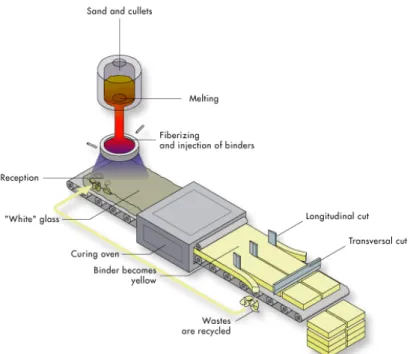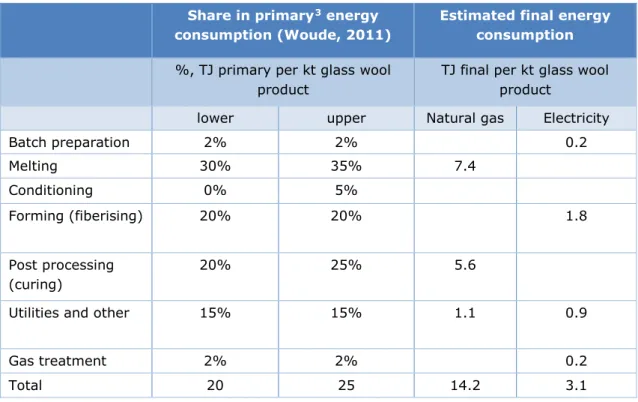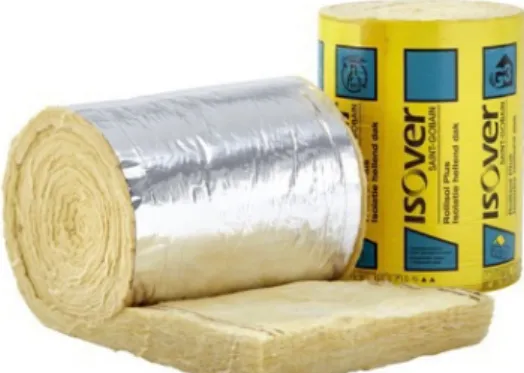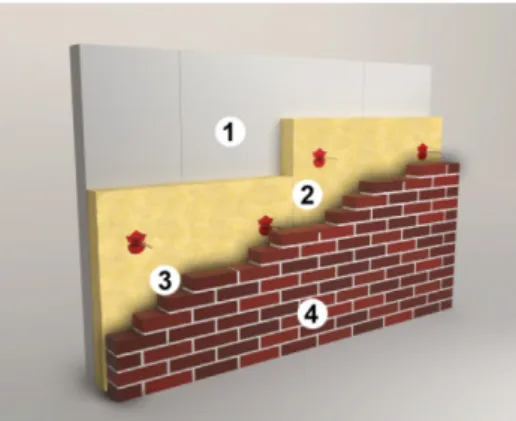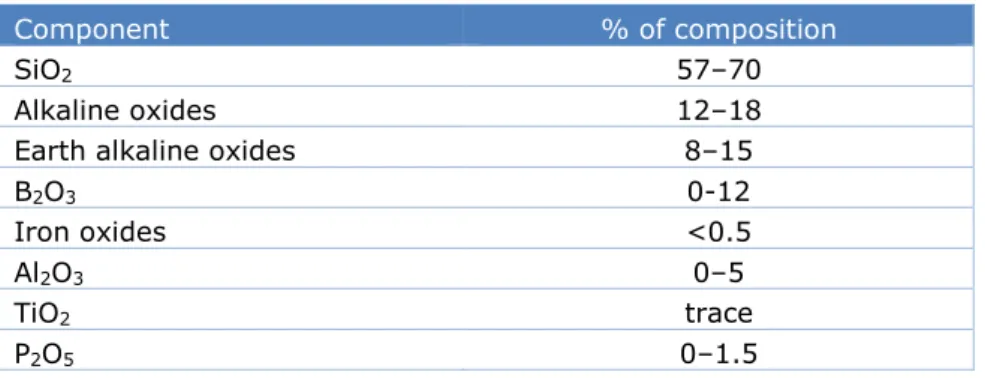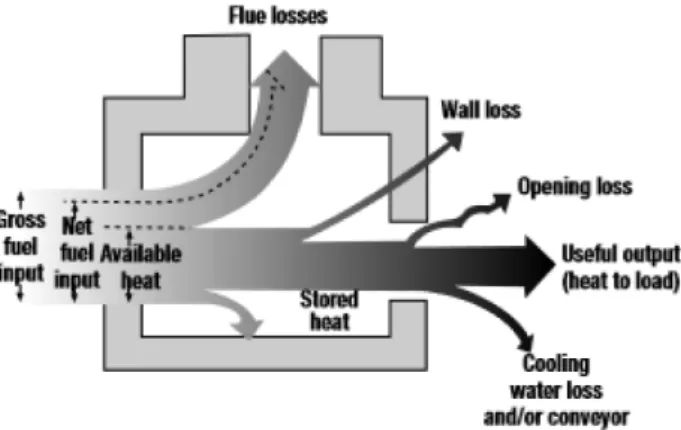DECARBONISATION OPTIONS
FOR THE DUTCH GLASS WOOL
INDUSTRY
R. Krijgsman, M. Marsidi
12 December 2019
Decarbonisation options for the Dutch glass wool industry
© PBL Netherlands Environmental Assessment Agency; © ECN part of TNO The Hague, 2019
PBL publication number: 3886
TNO project no. 060.33956 / TNO publication number: TNO 2019 P11696
Authors
R. Krijgsman and M. Marsidi
MIDDEN project coordination and responsibility
The MIDDEN project (Manufacturing Industry Decarbonisation Data Exchange Network) was initiated and is also coordinated and funded by PBL and ECN part of TNO. The project aims to support industry, policymakers, analysts, and the energy sector in their common efforts to achieve deep decarbonisation. Correspondence regarding the project may be addressed to: K.M. Schure (PBL), Klara.Schure@pbl.nl, or A.W.N van Dril (TNO), Ton.vanDril@tno.nl.
Production coordination
PBL Publishers
This publication is a joint publication by PBL and ECN part of TNO and can be downloaded from: www.pbl.nl/en. Parts of this publication may be reproduced, providing the source is stated, in the form: R. Krijgsman and M. Marsidi, 2019. Decarbonisation options for the Dutch glass wool industry. PBL Netherlands Environmental Assessment Agency and ECN part of TNO, The Hague.
PBL Netherlands Environmental Assessment Agency is the national institute for strategic policy analysis in the fields of the environment, nature and spatial planning. We contribute to improving the quality of political and administrative decision-making by conducting outlook studies, analyses and evaluations in which an integrated approach is considered paramount. Policy relevance is the prime concern in all of our studies. We conduct solicited and
unsolicited research that is both independent and scientifically sound.
ECN part of TNO has a twofold mission: to accelerate the energy transition and to strengthen the competitive position of the Netherlands. ECN part of TNO conducts independent and internationally leading research and we stand for an agenda-setting, initiating and supporting role for government, industry and NGOs.
This report was reviewed by Saint-Gobain. PBL and ECN part of TNO remain responsible for the content. The decarbonisation options and parameters are explicitly not verified by the companies.
Contents
Summary 4
INTRODUCTION
5
1
GLASS WOOL PRODUCTION IN THE NETHERLANDS
6
1.1 General info 6
2
GLASS WOOL PRODUCTION PROCESSES
7
2.1 Process description 7
2.1.1 Batch preparation and melting 8
2.1.2 Forming 9
2.1.3 Downstream process 9
2.1.4 Glass veil forming 10
2.2 Energy and emissions 10
2.3 Production equipment 12
2.4 Investment costs 12
3
GLASS WOOL PRODUCTS AND APPLICATION
14
3.1 Product description 14
3.2 Materials 15
4
OPTIONS FOR DECARBONISATION
17
4.1 Energy efficiency options 17
4.2 All-electric furnaces 18
4.3 Oxy-fuel furnaces 19
4.4 Green gas 19
4.5 Hydrogen 20
FINDINGS
Summary
Glass wool is a product used for thermal insulation of buildings (walls, roofs, floors, etc.), in heating and ventilation applications, in industrial (technical) installations (process pipework, vessels, chemical plant, offshore and marine), for fire protection, in acoustics (sound
absorption and insulation), and as an inert growing media and soil conditioning. Glass wool is produced in the Netherlands by Saint-Gobain Construction Products Nederland B.V. in Etten-Leur. It is estimated that the company currently produces 60 kilotonnes of glass wool and glass-fleece products annually, from various minerals and recycling flows. The total CO2
emissions of glass wool production in the Netherlands amounted to 56.5 ktonne per year in 2017. Most of the CO2 emissions are related to the melting process. Around 11% of the CO2
emissions are process emissions that are released during the melting of the raw material. The total energy consumption is estimated to consist of 0.86 PJ natural gas and 0.2 PJ final electricity consumption.
An important decarbonisation option is the electrification of the melting furnaces. Further on-site decarbonisation options consist of energy efficiency measures, and alternative fuels like upgraded biogas and hydrogen to replace natural gas consumption.
FULL RESULTS
Introduction
This report describes the current situation for glass wool production in the Netherlands and the options and preconditions for its decarbonisation. The study is part of the MIDDEN project (Manufacturing Industry Decarbonisation Data Exchange Network). The MIDDEN project aims to support industry, policymakers, analysts, and the energy sector in their common efforts to achieve deep decarbonisation. The MIDDEN project will update and elaborate further on options in the future, in close connection with the industry.
Scope
In the Netherlands, glass wool producers include: Saint-Gobain Construction Products Nederland B.V. (Etten-Leur). Production processes include mineral melting, forming, curing; products include: glass wool mats, glass wool veils (fleece).
Reading guide
Section 1 introduces the Dutch glass wool industry. Section 2 describes the current situation for glass wool production processes in the Netherlands, and Section 3 describes the relevant products of these processes, while options for decarbonisation are systematically quantified and evaluated in Section 4.
1 Glass wool production
in the Netherlands
1.1 General info
Saint-Gobain Construction Products Nederland B.V. produces various kinds of glass wool mats and fleece. Glass wool is produced in an extensive range of products, where size, thickness and properties like fire resistance all define the differences between products. Saint-Gobain Construction Products Nederland B.V.’s main market is the built environment, but the company’s product portfolio also includes industrial and naval applications.
Gobain Construction Products Nederland B.V. is part of the French company Saint-Gobain1, one of the world largest producer of building materials with around EUR 42 billion in
annual revenues and 180,000 employees worldwide (Saint-Gobain, 2019). The insulation branch of Saint-Gobain, called Saint-Gobain Isover, has 10,000 employees spread over 63 production locations worldwide (Gobain, 2019b). The Dutch production site of Saint-Gobain Isover in Etten-Leur produces both glass wool (product name Isover) and glass veil (fleece, product name Adfors) (Adfors, 2018), and is listed as Saint-Gobain Construction Products Nederland B.V. Saint-Gobain Construction Products Nederland B.V. employs around 225 staff.
Saint-Gobain Construction Products Nederland B.V. had an estimated annual production capacity in 2006 of around 45,000 tonnes of glass wool and glass fleece2 (Kroezen,
Schroten, & Singels, 2006). It is estimated that the company currently produces 60 kilotonne of glass wool and glass fleece products annually. The glass wool production site is part of a commercial area with light industry to the west of Etten-Leur.
Table 1 Saint-Gobain Construction Products Nederland B.V. general info
Characteristics
Name Saint-Gobain Construction Products Nederland B.V. NL
Address Parallelweg 20
Postal code 4878AH
Locality Etten-Leur
Employment (2019) 225
ETS data (2017) 56.5 ktonnes of CO2eq
Corporate group Saint-Gobain
1 The Saint-Gobain headquarter is located in Courbevoie, France.
2 This report is focused on glass wool production, which is assumed to be the main product. There is less
information on glass veil (fleece). Glass fleece is also produced by Owens Corning Veil Nederland B.V. in Apeldoorn, participating under ETS, with emissions in 2017 amounting to 19.7 kton
2 Glass wool
production processes
2.1 Process description
Figure 1 depicts the glass wool manufacturing process. The first step is to create the correct mixture of input materials (1). These materials are then melted in the gas-fired melting furnace at around 1400oC (2). The melt is then directed along a heated refractory-lined
forehearth and poured into spinning machines that use rotational forces to fiberise the melt (3). A chemical binder is then sprayed on to the fibres to provide integrity, resilience,
durability and handling quality. The fibers are then heated and compressed, and the binder is hardened to bond the fibres together into mats and dried at 200oC in a curing oven running
on natural gas (4). After that, the products are cut to size (5) and then packaged (6) and prepared for transport to the customers (7).
Figure 1 Glass wool manufacturing process (Isover Saint-Gobain, 2019)
The biggest material losses come from the forming step and the cutting of the mats. These losses are for the most part recycled and used again as input product. The recycling of internal recycling cullet and cutting losses, is estimated to make up 10-15% of the material input. Cullets from external streams make up 50% or more of the material input.
An overview of the material flow and energy consumption is presented in Figure 2. The temperatures mentioned are representative for a typical glass wool production plant based on literature (JRC, 2013). The process temperatures of Saint-Gobain Construction Products Nederland B.V. are slightly lower due to performed energy efficiency projects.
Figure 2 Overview of the glass wool production process
The production process steps are discussed below in more detail.
2.1.1 Batch preparation and melting
The main materials for glass wool production are sand, soda ash, dolomite, limestone, sodium sulphate, sodium nitrate, and minerals containing boron and alumina. Process waste and other forms of glass cullet (e.g. recycled container glass and soda-lime-silica flat glass), are also used as raw material. The primary raw materials inputs are monitored and adjusted to achieve the required composition of the melt (JRC, 2013). The use of glass cullet depends on the cost, composition, purity and consistency of supply. An increasing problem is the presence of glass-ceramics in recycled cullet (JRC, 2013).
Once the ingredients have been fed into the furnace, they are melted. This is a continuous process, the furnaces are in permanent operation and the ingredients are continuously fed
into the furnace, providing a steady flow of output. No recent data was found, but according to literature Saint-Gobain Construction Products Nederland B.V. operated two recuperative furnaces in 2007 (Beerkens, 2007). Hot flames / flue gases heat the raw materials and melt (up to 1400 oC); the remaining heat content of the flue gases leaving the glass furnace are
partly recovered by preheating combustion air by means of a recuperative heat exchanger. The quality of the melt is determined by the residence time, temperature, quality of input materials.
2.1.2 Forming
Fiberising of the melt determines the shape and diameter of the fibres. After the furnace, the melt is led through heated channels and poured into the spinners. Fiberising takes place by means of centrifugal action of the rotating spinner with further attenuation by hot flame gases from a circular burner. This forms a veil of fibres with a range of lengths and diameters randomly interlaced (JRC, 2013). The phenolic resin based binder, diluted with water (JRC, 2013) is added to the newly formed fibres. The binder is applied to create a consistent porous structure of the product and protects the fibres during the downstream process.
The fibres then fall down onto a conveyor belt, which leads them towards the curing oven. Figure 3 is a visualisation of the fiberisation step and the downstream production process.
Figure 3 Visualisation of the glass wool production process (EURIMA, 2019)
2.1.3 Downstream process
The downstream process consists of curing and packaging. The curing oven, approximately 200–250oC) runs on natural gas, dries the product, and turns the flexible fibres into semi-
rigid mats that are held together by the resin binder (JRC, 2013). It also serves the purpose of hardening the fibres. The characteristic yellow color of the end product is caused by the binder after hardening in the curing oven.
After curing, the product is air-cooled, cut, and readied for shipping or processing into end products. Waste is used as a loose-form product or recycled (JRC, 2013). Almost all of the internal waste is recycled by using it as input material. Around 1–3% of the output has no application and is disposed of as waste (Saint-Gobain Isover, 2019a).
The mats can be compressed to up to a tenth of their volume, which results in more efficient transportation. The mats are packed in plastic foil and prepared for transport on pallets. The cooling installation, cutters and packaging machines run on electricity (Saint-Gobain Isover, 2019).
2.1.4 Glass veil forming
Saint-Gobain Construction Products Nederland B.V. has three production lines for the technical fabric dry laid process. The fibres are produced directly from one of the furnaces (the other furnace is used for the production of glass wool) that is above the conveyor belt which forms the veil. Figure 4 illustrates the process (Saint Gobain Adfors, 2017).
Figure 4 Visualisation of the glass veil production process (Saint Gobain Adfors, 2017)
There are no specific technical data available for this glass fleece process. Melting and curing processes for glass fleece production are assumed to have the same characteristics as described for glass wool production.
2.2 Energy and emissions
Table 2 depicts the material and energy inputs required for the production of glass wool. The table provides figures for a typical glass wool production process. Total final energy
consumption is calculated to be around 17 TJ/kt product, of which 14 TJ/kt is natural gas and 3 TJ/kt is electricity. Per tonne of product, about 0.11 tonne of waste is assumed to be produced (mainly from the fiberiser and cutter processes and from manufacturing faults). Although the actual specific energy and material consumption of glass wool production varies per year (depending on among others the age of the furnace), the figures in Table 2 can be considered representative for the average specific energy and material consumption of Saint-Gobain Construction Products Nederland B.V.
Table 2 Material and energy inputs per tonne glass wool product
Input Unit per kt glass wool product
Value Source
Glass cullet kt 0.55 (Saint-Gobain Isover, 2018)
Sand kt 0.33 (Integrated Pollution Prevention and
Control (IPPC), 2001)
Soda-ash +Limestone kt 0.18 (Integrated Pollution Prevention and Control (IPPC), 2001)
Binders kt 0.06 (Integrated Pollution Prevention and
Control (IPPC), 2001)
Natural gas TJ 14 (Nederlandse Glasindustrie, 2011)
Electricity TJ 3 (Nederlandse Glasindustrie, 2011)
Output
Glass wool product kt 1 Reference unit
Internal waste kt 0.11 (Integrated Pollution Prevention and Control (IPPC), 2001)
- of which is recycled kt 0.09 Calculated
- no application kt 0.02 (Saint-Gobain Isover, 2019)
CO2 emissions kt 0.9 Calculated
A tentative estimate is made on the energy requirement for the separate process steps, included in Table 3, based on (Woude, 2011).
Table 3 Estimated current energy requirement for separate process steps
Share in primary3 energy
consumption (Woude, 2011)
Estimated final energy consumption
%, TJ primary per kt glass wool product
TJ final per kt glass wool product
lower upper Natural gas Electricity
Batch preparation 2% 2% 0.2 Melting 30% 35% 7.4 Conditioning 0% 5% Forming (fiberising) 20% 20% 1.8 Post processing (curing) 20% 25% 5.6
Utilities and other 15% 15% 1.1 0.9
Gas treatment 2% 2% 0.2
Total 20 25 14.2 3.1
The yearly greenhouse gas emissions of the site have increased by 1/3 over the period of 2013–2017 (see Table 4) as result of production increase. Most of the CO2 emissions are
related to combustion of natural gas, 11% are process emissions, mostly from the chemical decomposition of limestone. The emissions have increased every year from 2013 due to an
increase in production. This production increase was achieved by more efficient use of their production facilities. A current yearly production of 60 kt final product output is estimated based on the reported NEA emissions, a specific gas consumption of 14.2 GJ per tonne product and process emissions of 11% of the reported NEA emissions.
Table 4 Reported greenhouse gas emissions (CO2eq), NEA
Plant 2013 2014 2015 2016 2017
Saint-Gobain Construction Products
Nederland B.V. 42,023 43,848 49,799 54,266 56,467
Aside from greenhouse gas emissions, glass wool production also results in sulphur dioxide and nitrogen oxides. In the forming area, emissions are likely to contain levels of particulate matter, phenol, formaldehyde, ammonia and water. Curing oven emissions will contain volatile binder components, binder breakdown products, and combustion products (JRC, 2013). Saint-Gobain Construction Products Nederland B.V. has installed treatment facilities for these emissions.
2.3 Production equipment
There were two glass recuperative type furnaces in use at Saint-Gobain Construction Products Nederland B.V. in 2007. Both furnaces were gas-fired. The incoming air was preheated (500–600oC) using steel recuperators (TNO, 2007). In 2009, a new glass furnace
was installed to replace one of the older glass furnaces. The new glass furnace came equipped with a two-step heat recovery unit and heat exchangers to produce steam from waste heat (Saint-Gobain Isover, 2019a). Recuperative furnaces can run for approximately 8 (JRC, 2013) to 10 years before a major refurbishment is needed according to JRC (2013)4.
Based on calculated net production, the current furnace melting capacity should be around 70,000 tonne/year, or 190 tonne/day.
The purpose of the curing oven is to polymerise binding agents previously mixed with the fiber in the fiberising zone. The curing process uses hot air. The oven consists of different sections connected with each other, each section is autonomous and has its own system for hot air recirculation (Gamma Mechanica, 2016) (Münstermann, 2012). The hot air in the curing oven is assumed to be directly produced with natural gas.
A new shredder was installed in 2005to make glass wool production waste that cannot be recycled on-site suitable for other purposes. This reduced the amount of glass wool end-waste to less than 1% (Saint-Gobain Isover, 2019a).
2.4 Investment costs
The BREF document mentions investment costs of around EUR 3–5 million for a complete furnace rebuild of capacities around 250 tonnes/day. Saint-Gobain Construction Products Nederland B.V. notes that these costs differ for rebuilding an electric furnace or a gas-fired furnace, with the rebuild of a gas-fired furnace being more expensive. It is also noted that the mentioned EUR 3–5 million investment costs are on the low side and that in practice the investment costs for rebuilding a furnace are considerably higher.
4 According to (JRC, 2013) the upper end of the lifetime is 12 years but in practice major refurbishments are
The investment costs for a complete factory with a production capacity of around 60 ktonnes per year amount to EUR 100 million (JRC, 2013). Again, this depends on the type of furnace that is installed. When installing an electric furnace the investment costs can significantly increase due to the extra costs related to reinforcing both the onsite and external electric infrastructure.
3 Glass wool products
and application
3.1 Product description
Saint-Gobain Construction Products Nederland B.V. at Etten-Leur produces glass wool in various grades of density, thickness and size. These are used for different applications, such as industrial insulation, insulation of buildings and acoustic absorption. The glass wool is tailored to meet these requirements. Saint-Gobain Construction Products Nederland B.V. also produces glass veil fleece (Adfors) which is mostly used for acoustic applications, and
covering (e.g. roof covering).
Saint-Gobain Construction Products Nederland B.V.’s production was estimated to be around 45 kilotonnes per year in 2006 (Kroezen, Schroten & Singels, 2006). It is estimated that the current production capacity is 60 kt per year (see section 2.2). Saint-Gobain Construction Products Nederland B.V. and the insulation industry organisation Eurima claim glass wool mats are infinitely recyclable. The current recycled content of glass wool from Saint-Gobain Construction Products Nederland B.V. is up to 70% of the material input. The recycled content consists mainly of glass cullet (Saint-Gobain Isover, 2018).
Two manufacturers of mineral wool are situated in The Netherlands, Saint-Gobain
Construction Products Nederland B.V. and Rockwool Benelux. Rockwool Benelux is situated in Roermond and produces around 300 ktonne stone wool annually. Combined, Saint-Gobain Construction Products Nederland B.V. and Rockwool Benelux produce around 9% of all mineral wool in Europe. For thermal insulation of buildings, also plastic foams are commonly used like expanded polystyrene and polyurethane. There is no dominant choice of material for building insulation.
Glass wool blanket rolls are cheaper than glass wool panels. Prices for rolls vary between EUR 4 and EUR 11 per square meter, depending on thickness and properties. Glass wool panels used for filling cavity walls are more expensive, around EUR 25 per square meter. Panels and specialty products are generally more rigid. Panels for other purposes, like acoustic absorption, have similar prices.
Figure 6 Cavity wall insulated with glass wool (Saint-Gobain Isover, 2019).
Figure 7 White glass fibre veil (Saint Gobain Adfors, 2017)
Mineral wool products have a low value to volume ratio, which limits the distance over which they can economically be transported. Extra-EU trade is less than 5% of the output (JRC, 2013). There is, however, still significant trade within the EU. Low density glass wool products, like blankets, are easier to compress during transport and handling, which represents a transport cost advantage.
3.2 Materials
Table 5 depicts the typical composition of a glass wool product. The silica oxide is provided by the sand and glass cullet.
The binder is not included in the table, but water soluble phenolic resins are the most commonly used binder and are typically 2-5% of the total mass. Prices range between USD 2-5 per kg (Alibaba, 2019). Binders can contain ammonia, urea, mineral oil, silicone, silane and water. The exact formulation of the used binder is typically confidential information. There is a trend to apply more ‘green binders’ which are sugar based.
Input materials are silica sand, process cullet, external cullet, internal recycling cullet and process cutting losses, nepheline syenite, sodium carbonate, potassium carbonate,
limestone, dolomite, sodium sulphate, borax, colemanite, ulexite. It is assumed that Saint-Gobain Construction Products Nederland B.V. sources the main raw materials, such as low value inputs like silica sand, cullet, soda-ash and limestone, from within Europe.
Table 5 Typical composition of fibres in glass wool (JRC, 2013)
Component % of composition
SiO2 57–70
Alkaline oxides 12–18
Earth alkaline oxides 8–15
B2O3 0-12
Iron oxides <0.5
Al2O3 0–5
TiO2 trace
4 Options for
decarbonisation
The largest potential of CO2 reduction is in the melting and curing steps. The melting and
curing ovens are responsible for around 75% of the final energy consumption.
4.1 Energy efficiency options
Saint-Gobain Construction Products Nederland B.V. participates in the MEE-covenant on energy efficiency. Under the covenant, companies are required to consider efficiency options with a payback period of less than five years. From 2009–2017 the total glass industry improved its energy efficiency by 8.5%.
There are no recent individual MEE-results available regarding the energy efficiency progress of Saint-Gobain Construction Products Nederland B.V. The company states that compared to 1999, energy use and CO2 emissions per tonne of product have decreased by 30%. The
replacement of a furnace in 2009 contributed to this improvement (Saint-Gobain Isover, 2019a) (Saint Gobain Isover, 2011). The annual average energy efficiency improvement rate was 2%. Future annual energy efficiency improvement rates are estimated to be 1%. The options mentioned in this section are expected to be already implemented to some extent. From literature, energy efficiency options include:
• Improving gas fired furnace design • Batch preheating with waste heat
• Using waste heat for steam generation and other purposes
• Lowering the reaction energy of sand, soda and lime by increasing the share of cullet.
Improving gas fired furnace design
Heat losses of the furnace pose considerable challenges for energy efficiency. The biggest heat loss in a recuperative glass furnace comes from heat lost via the flue gases. Other losses originate from opening losses and losses through the furnace walls, as illustrated in Figure 8.
Flue gas heat is recovered by indirect heating of cold incoming air to 500–600oC. This
principle of a recuperative furnace design is applied by Saint-Gobain Construction Products Nederland B.V. Regenerative furnaces, which store flue gas heat in refractory lined chambers and can achieve higher energy recovery from the flue gas heat, are generally not used for the furnace capacities commonly used for glass wool production5.
Batch preheating with waste heat
Further recovery of flue gas heat can be applied to batch pre-heating; increase the input material temperature to make it easier to melt when it enters the furnace. Note however that preheating of batch is not trivial especially in case of low cullet content batches resulting in operational issues like clogging. In addition, preheating raw material might result in dust formation affecting furnace integrity. Process (and raw material) measures are required to anticipate on these side-effects (Celsian, 2019).
Using waste heat to produce steam
A potential way to recover heat from flue gas is to use heat exchangers to produce steam. Saint-Gobain Construction Products Nederland B.V. is using waste heat from flue gases to produce steam in a two-step recovery installation (Saint-Gobain Isover, 2019a).
A possibility that could be further investigated is to use the residual heat from the melting furnaces to heat the curing ovens. Due to the presence of corrosive elements in the flue gas, a heat exchanger would be needed to make use of the residual heat. The remaining (low temperature) heat could be used for climate control in offices, production and storage halls, or used externally.
Excess heat from Saint-Gobain Construction Products Nederland B.V. could also be used for district heating in the vicinity. In Etten-Leur there are some smaller urban housing projects and the city of Breda is heated by a heat network. This may present an opportunity for providing waste heat from the Saint-Gobain Construction Products Nederland B.V. plant in Etten-Leur (Klimaatbureau HIER, 2019). There are currently no known initiatives for external use of waste heat of Saint-Gobain Construction Products Nederland B.V.
Increasing cullet share
Increased shares of glass cullet in the melt have shown to decrease the energy needed to melt the raw materials (JRC, 2013). A 10% increase in the share of glass cullet provides a 2– 3% increase in energy efficiency. It must be noted, however, that the glass shares must be of sufficient quality and purity as to not compromise the quality of the glass wool (Worrell, Galitsky, Masanet, & Graus, 2008) and also the integrity of the furnace walls and emissions. In addition, cullet of poor quality can even result in an increase in energy consumption in case the poor quality of cullet leads to (excessive) foam formation preventing efficient heat transfer from flames towards the raw materials and the glass melt (Celsian, 2019).
Optimising production by reducing production losses in general improves overall efficiency, including energy efficiency.
4.2 All-electric furnaces
Electric furnaces represent a large potential for decarbonisation. The technology is
commercially available on a smaller scale. This would be a major step in decarbonisation. All-electric furnaces use All-electricity to provide heat. Resistive heating is mostly used in the glass industry and makes use of electrodes that are inserted in the melt. The electrodes pass
5 A reason to not use regenerators in boron-containing glass wool production is the corrosion of checkerwork
electricity in the melt. Because of the high resistance of the materials, the electricity
produces heat, which is used to melt the materials. Resistive heating is the only method that has found a commercial application in this industry. Compared to fossil fuel fired furnaces, full electric furnaces have higher energy efficiency. Electric furnaces are generally applied in small-scale applications. For larger scale furnaces, the higher electricity price and lower lifetime compared to fossil fuel fired furnaces largely offsets the efficiency gain6, even though
electric furnaces are still more efficient (JRC, 2013) (Worrell, Galitsky, Masanet, & Graus, 2008).
It is unknown whether all-electric curing ovens are commercially available or could be developed. In other sectors, they are being sold, however (Despatch, 2019). Costs of electricity versus gas are decisive for larger scale applications, if there are no specific advantages for electrically heated processes. In general, the electricity price is higher than the natural gas price based on energy content. Also note the significant additional
investment costs required for an electric furnace related to the strengthening of the internal and external electricity infrastructure.
Electric furnaces are around 25% more efficient than conventional furnaces, depending on the type. No efficiency information could be found of hybrid furnaces. With two all-electric furnaces, the CO2 emissions of the total production facility would be reduced by 50%. The
remaining sources of emissions would be process emissions and emissions from curing and minor utilities.
4.3 Oxy-fuel furnaces
Oxy-fuel furnaces are applied in both the glass sector and stone wool sector. They use oxygen for combustion instead of air, so the nitrogen in the air does not have to be heated and transported. In a conventional furnace, typically 20–30% (Celsian, 2019) of energy is lost in flue gases and oxy-fuel combustion reduces the amount of flue gases by 60–70%. However, the electric energy consumption of air separation to provide oxygen is estimated to be 7–8% of the energy content of the fuel input (JRC, 2013). Application of oxy-fuel furnaces can reduce energy losses by up to 25–35% compared to a recuperative furnace without additional heat recovery (
waste heat boiler or cullet preheating)
(JRC, 2013)7. Recuperativeand regenerative furnaces re-use waste heat by design. The reduced volume of flue gases in oxy-fuel furnaces will limit the heat recovery potential8. For Saint-Gobain Construction
Products Nederland B.V., an energy efficiency improvement of 10–15% is assumed possible.
4.4 Green gas
Biogas can be upgrade to have the same qualities as regular natural gas (largely consisting of methane). In order to upgrade biogas, e.g. from digesters, into green gas that is suitable for the natural gas grid, it needs to have the same calorific value as regular natural gas. This is done by removing impurities and CO2 from the gas (Energiekaart, 2019). The green gas
6 The efficiency of fossil fuel furnaces also increases with scale, reducing the relative efficiency advantage of
its electric counterpart.
7 Note that regenerative furnaces can reach same energy consumption values as oxyfuel-fired furnaces and
are not per definition more energy efficient (Celsian, 2019).
8 Generally, oxyfuel fired furnaces do not reclaim flue gas waste heat; currently, two techniques are in
industrial demonstration phase to capture heat from the hot oxyfuel flue gases: HeatOX (Air Liquide technology to preheat oxygen and natural gas) and Optimelt (Linde technology to create high caloric
can be used to substitute natural gas for the furnace and curing oven9. In this case no major
adjustments are needed. Replacing all natural gas with green gas would come with increased expenses but the emissions would be reduced to only the process emissions. Regular biogas supply is a problem, however. The currently available biogas supply would need to be scaled up significantly to be able to substitute the current natural gas demand of Saint-Gobain Construction Products Nederland B.V.
Investments to adjust the production facilities would be minor, but a separate green gas infrastructure may be required. When using only upgraded biogas for both the melting furnaces, the curing ovens and minor facilities, the only emissions that would be left are process emissions. The total emission reduction would be 89%.
4.5 Hydrogen
During the past two years, hydrogen has gained attention in the glass industry (Celsian, 2019) as a potential substitute for natural gas. To be considered a renewable option, the hydrogen has to be produced from electrolysis using renewable electricity (green hydrogen) or from natural gas in combination with CCS to mitigate CO2 emissions (blue hydrogen).
Combustion of hydrogen has the advantage of not emitting CO2 emissions. For 100% use of
hydrogen, oxyfuel burners could be used to combust the hydrogen with pure oxygen, instead of air, to avoid nitrogen oxide (NOx) formation10.
Questions that therefore need to be answered are how furnace design needs to be altered, especially when looking at the burners, and how the different fuel will affect the melting process and melting efficiency. The combustion efficiency changes (H2-combustion compared
to NG-combustion) depends on the efficiency of heat transfer which is still a topic of research (Celsian, 2019). The challenges lie in the higher flame temperature at 2200°C compared to 1900°C for natural gas (The Engineering Toolbox, 2003). Combustion properties are different to natural gas. The flame radiation is less effective, and the produced water from combustion may affect furnace operation (PB & DNV GL, 2015). Also note that the energy efficiency might be increased by potential increased foam formation, furnace integrity might be affected by changed combustion atmosphere and also glass quality (seed count) is likely to be influenced by modified fining of glass melts as consequence of higher water
concentrations in the combustion atmosphere (Celsian, 2019).
The availability of affordable hydrogen produced from renewable electricity (green hydrogen) or hydrogen produced from natural gas in combination with CCS (blue hydrogen), is
currently also a limiting factor. The current natural gas infrastructure can be refurbished to allow it to transport hydrogen. As a fuel, hydrogen is more expensive than electricity or natural gas (van Wijk, 2018).
As combustion only produces water, the only remaining greenhouse gas emissions would be process emissions, resulting in an 89% emission reduction. Energy inputs over the total plant would theoretically decrease, but the actual efficiency of hydrogen in melting furnaces is unknown.
9 The use of non-upgraded biogas or syngas from biomass gasification could potentially also be applied. Further
research is needed to determine the implications this would have on the production process.
10 Note that large H2-burners still have to be developed for industrial application of H2-combustion in the glass
References
Adfors. (2018). Homepage. Opgehaald van Adfors: http://www.adfors.com/eu/nl Alibaba. (2019, 03 22). phenol formaldehyde resin price. Opgehaald van Alibaba:
https://www.alibaba.com/showroom/phenol-formaldehyde-resin-price.html Beerkens, R. (2007). Inventory of SO2 emissions and emission reduction potential in the
Netherlands glass industry. . TNO.
Celsian. (2019). Commentary on MIDDEN report by Oscar Verheijen. (PBL, Interviewer) Despatch. (2019, 02 25). Curing ovens. Opgehaald van Despatch:
https://www.despatch.com/curing_ovens.aspx
Energiekaart. (2019, February 25). Wat is het verschil tussen biogas en groen gas? Opgehaald van Energiekaart: https://energiekaart.net/verschil-tussen-biogas-en-groen-gas/
EURIMA. (2019, 02 23). Production Process. Opgehaald van Eurima:
https://www.eurima.org/about-mineral-wool/production-process.html
Gamma Mechanica. (2016). Opgehaald van https://www.gamma-meccanica.it/mineral-wool-production-lines/glass-wool/curing-oven/?lang=en
Integrated Pollution Prevention and Control (IPPC). (2001). Reference Document on Best
Available Techniques in the Glass Manufacturing Industry.
Isover Saint-Gobain. (2019). Glass wool. Opgehaald van Isover Saint-Gobain: https://www.isover.com/glass-wool
JRC. (2013). Best Available Techniques (BAT) Reference Document for the Manufacture of
Glass, Industrial Emissions Directive 2010/75/EU (Integrated Pollution Prevention and Control). Luxembourg: European Union.
JRC. (2013). Best Available Techniques (BAT) Reference Document for the Manufacture of
Glass, Industrial Emissions Directive 2010/75/EU (Integrated Pollution Prevention and Control). Seville: European Commission Joint Research Centre.
Klimaatbureau HIER. (2019, 02 25). Wonen zonder aardgas in Etten-Leur. Opgehaald van Hier verwarmt: https://www.hierverwarmt.nl/gemeente/etten-leur
Kroezen, H. J., Schroten, A., & Singels, M. (2006). Stofemissies in de bouw(keten). Delft: CE.
Münstermann. (2012). Opgehaald van https://www.muenstermann.com/en/thermal- treatment/current-projects-drying-plants/wide-curing-oven-for-glass-wool-production
Nederlandse Glasindustrie. (2011). Voorstudie Nederlandse Glasindustrie 2030. Vereniging Nederlandse Glasindustrie.
PB & DNV GL. (2015). Industrial Decarbonisation & Energy Efficiency roadmaps up to 2050. London UK: WSP Parsons Brinckerhoff and DNV GL. Opgehaald van
https://assets.publishing.service.gov.uk/government/uploads/system/uploads/attach ment_data/file/416675/Glass_Report.pdf
Saint Gobain Adfors. (2017). YOUR PARTNER IN TECHNICAL TEXTILES brochure. Opgehaald van https://www.saint-gobain.com.cn/index.php/system/files/files/documents/Saint-Gobain%20ADFORS%2C%20your%20Partner%20in%20technical%20textiles.pdf Saint Gobain Isover. (2011). Planet People Prosperity brochure. Isover Saint Gobain. Saint-Gobain. (2019). About Saint-Gobain . Opgehaald van www.Saint-Gobain.com:
https://www.saint-gobain.com/en/group/about-saint-gobain Saint-Gobain. (2019b). Key figures. Opgehaald van www.isover.com:
https://www.isover.com/key-figures
Saint-Gobain Isover. (2018). Glass Wool. Opgehaald van Isover Technical Insulation: https://www.isover-technical-insulation.com/glass-wool
Saint-Gobain Isover. (2019, 02 23). Glasswool. Opgehaald van Isover Technical Insulation: https://www.isover-technical-insulation.com/glass-wool
Saint-Gobain Isover. (2019a). Milieuvriendelijk geproduceerd. Opgehaald van https://www.isover.nl/over-isover/milieuvriendelijk-geproduceerd
The Engineering Toolbox. (2003). Flame Temperature Gases. Opgehaald van The Engineering Toolbox: https://www.engineeringtoolbox.com/flame-temperatures-gases-d_422.html
TNO. (2007). Inventory of SO2 emissions and emission reduction potential in the Netherlands glass industry.
van Wijk, A. (2018, February 14). 'Waterstof is het nieuwe aardgas'. Opgehaald van profadvanwijk: www.profadvanwijk.com/waterstof-is-het-nieuwe-aardgas/
Worrell, E., Galitsky, C., Masanet, E., & Graus, W. (2008). Energy Efficiency Improvement
and Cost Saving Opportunities for the Glass Industry. Ernest Orlando Lawrence
Berkely National Laboratory.
Woude, J. v. (2011). Voorstudie Glasindustrie 2030. Vereniging Nederlandse Glasindustrie (VNG).



